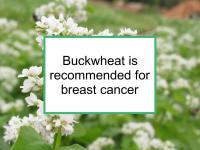Buckwheat (Fagopyrum esculentum), which is a type of seed rather than a grain, is rich in phytochemicals, including rutin, isoquercitrin, quercetin, catechin, myricetin and various anthocyanins. Buckwheat is also a dietary source of enterolactone, niacin, zinc, copper, selenium, and manganese.
Components of buckwheat have been found to have antioxidant, anticarcinogenic, antimutagenic, and antifungal properties. Consumption of buckwheat has been shown to reduce gut transit time compared to consumption of white rice, resulting in lower levels of triglycerides, total cholesterol and LDL cholesterol. Consuming buckwheat may also reduce gallstone formation, reduce inflammation and contribute to blood sugar control. One animal study found that germinated buckwheat had potent anti-fatty liver activities.
A component of buckwheat has been shown to reduce proliferation of multiple myeloma cells. Rutin (a glycoside of quercetin), a major active component of buckwheat, has been found to have anti-angiogenic activity against melanoma in mice, reducing the number of tumor-directed capillaries formed. Rutin also was found to inhibit the proliferation, migration and capillary-like tube formation of human endothelial cells.
Breast cancer-related effects of eating buckwheat
An extract of buckwheat hulls has been shown to have cytotoxic effects in human breast, liver and stomach cancer cells. A peptide of buckwheat seeds has been found to inhibit proliferation of liver and breast cancer cells, as well as leukemia cells. Tartary buckwheat (similar to buckwheat) has been found to have antiproliferative effects in human breast cancer cells. Buckwheat also has been shown to inhibit carcinogen-induced mammary tumors in laboratory rats by lowering circulating estrogen.
Postmenopausal women with breast cancer and a high intake of plant lignans such as enterolactone have been found to be less likely to die from their breast cancer than those with a low intake. Enterolactone has also been found to increase the sensitivity of breast cancer cells to radiation, thereby potentially enhancing the treatment effects of radiotherapy.
Rutin has been reported to reduce the cardiotoxic effects of doxorubicin chemotherapy.
Quercetin
Buckwheat flavonol quercetin has been shown to increase the effectiveness of both doxorubicin and paclitaxel in multidrug resistant ER+/PR+ breast cancer cells, in part by eliminating cancer stem cells. In addition, quercetin has been reported to increase the sensitivity of ER+/PR+ cells to 5-fluorouracil (5-FU), thereby increasing its treatment effects. Quercetin has also been shown to inhibit aromatase, thereby supporting anti-estrogen treatment.
Quercetin has also been reported to inhibit the migration and adhesion of triple negative (ER-/PR-/HER2-) breast cancer cells and to significantly inhibit tumor progression in a mouse model of triple negative breast cancer. Quercetin has also been shown to enhance the anti-tumor activity of cisplatin while reducing it's adverse side effects. Quercetin also acts as an iron chelator, which can help reduce iron's breast cancer-promoting effects in some women. Finally, quercetin has been reported to sensitize cancer cells to radiotherapy.
Copper content
100% buckwheat flour products should be consumed in moderation since buckwheat is relatively rich in copper (approximately 0.43 mg per ounce). One 2024 study found that relatively high levels of copper in the urine of girls were associated with increased breast density two years after menarche. On the other hand, other studies have reported that while copper does appears to increase the risk of recurrence, it does not heighten risk of primary breast cancer significantly. Copper has been shown to promote angiogenesis and metastasis, especially in aggressive forms of breast cancer such as inflammatory (IBC), triple negative, and HER2-positive (HER2+) breast cancer.
Although copper is a vital nutrient, women with breast cancer probably should not exceed the RDA (recommended dietary allowance) of approximately 0.9 mg unless they are anemic. High copper foods such as calf's liver and beef liver should be avoided. Foods with moderate copper content, such as shellfish, textured soy protein, chocolate, most tree nuts, and sunflower seeds also should be limited or avoided. Copper consumption should be reserved for recommended foods. For example, walnuts incorporate approximately 0.45 mg copper per ounce, but have exceptional anti-breast cancer properties.
Note that products such as buckwheat pancakes and soba noodles typically have a far lower copper content than buckwheat since they are usually made with wheat as well as buckwheat flour.
Additional comments
Buckwheat honey has been found to be a better source of antioxidants than lighter-colored honeys. Japanese soba noodles are typically made from a combination of wheat and buckwheat flour.
Tartary buckwheat (Fagopyrum tataricum Gaertn.) is a type of buckwheat regularly consumed in China and parts of India. It has a phytochemical profile similar to common buckwheat, with somewhat more rutin and quercetin.
Sources of information provided in this webpage
The information above, which is updated continually as new research becomes available, has been developed based solely on the results of academic studies. Clicking on any of the underlined terms will take you to its tag or webpage, which contain more extensive information.
Below are links to 20 recent studies concerning this food and its components. For a list of studies that includes older research, please click on buckwheat.
